Focal mechanism and seismogenic structure of the Shiqu MS4.4 earthquake
Yanming Yang,Shubo Wang,Riya Su
Earthquake Agency of Inner Mongolia Autonomous Region,Hohhot,010010,China
Keywords:Shiqu Focal mechanism Seismogenic structure Qinghai-Tibetan plateau Xianshuihe fault zone
ABSTRACT The focal mechanism solution of the Shiqu MS 4.4 earthquake occurred on May 16th,2017 in Sichuan Province is studied by the gCAP method using the waveform data from the regional seismic networks in Sichuan,Qinghai,Tibet and Gansu provinces.The strike/dip/dipping angle of the first nodal plane are 214°/80°/167° and those of the second nodal plane are 306°/77°/10°,the optimal centroid depth is 7.3±0.6 km and the moment magnitude is MW 4.5.Furthermore,the study investigates the robustness of the results against the error of crustal velocity structure,location,data quality and difference of seismic parameters,subsequently obtaining a stable resolved focal mechanism.According to the geological structure in the seismogenic area,spatial distribution of aftershock sequenceof the regional tectonic stress field,and the focal mechanism of the main shock,we suggest that the Shiqu earthquake is induced by a left-lateral strike-slip mechanism and the second nodal plane is inferred to be the seismogenic fault,consistent with the geometry of the Changshagongma fault which is the secondary fault of the northwest part of the Xianshuihe fault zone.
1.Introduction
An MS4.4 earthquake with a focal depth of 10 km occurred in Shiqu County (33.05°N,99.00°E),Sichuan Province at 00:20 Beijing time on May 16th,2017.The epicenter is located in the eastern margin of Qinghai-Tibetan Plateau,a place situated in the junction of Sichuan,Qinghai,and Tibet.The Qinghai-Tibetan Plateau is compressed by the Indian Plate in the northeast direction but is blocked at the northern,northwestern,and northeastern boundaries.These tectonic forces have resulted in shortening in the northeast direction and the eastern escape flow of the interior materials in this plateau,thereby forming a series of northwest-oriented fault and fold systems in the periphery of the plateau and substantial rifts and large strike-slip fault systems in the interior of the plateau(Rowley,1996;Zhang et al.,2004).The eastern escape flow of the materials in the deep interior is blocked due to the rigidity of the Sichuan Basin and thus splits into two branches:flowing around the basin and squeezing outward in the southeast and northeast directions(Zhang et al.,2010).The seismogenic region consists of numerous northwest-oriented faults (Bureau of Geology and Mineral Resources of Sichuan Province,1987),of which the Xianshuihe fault zone is one of the deepest and largest fault zones with the most intensive neotectonic activities and deformations in China (Li,1993) and is characterized by excellent linear lineament (Wang,1993).In the West Sichuan Plateau,faults are mostly distributed in grid-shaped arrangement.Since the original northwest-oriented tectonic lineaments are highly developed,the northwest-oriented faults are under a large shear stress field and are therefore prone to slip.As a result,the northwest-oriented faults have more intense and frequent seismic activities compared with the northeast-oriented faults.Shear action is the principal seismogenic mechanical factor (Bureau of Geology and Mineral Resources of Sichuan Province,1987).The Xianshuihe fault zone has been in a seismic active period since the beginning of recorded history (Zhang and Xie,2001).Since the Cenozoic Era,the Shiqu area has been dominated by intermittent,intense uplifts (Wang,1993) and has experienced intense seismicity and continuous occurrence of small earthquakes.Furthermore,since the availability of observational data,the area has experienced 25 earthquakes with a magnitude of MS3.0 or above,including 17 earthquakes with a magnitude ranging of MS3.0–3.9,five earthquakes with a magnitude ranging of MS4.0–4.9,and two earthquakes with a magnitude ranging of MS5.0–5.9(and an MS7.0 earthquake in March 1896(this the strongest earthquake recorded in the history in this area) (Fig.1a).The earthquakes were concentrated in the fold zone north of the Garz^e-Yushu fault zone and mainly occurred on the northwest-oriented tectonic belts.
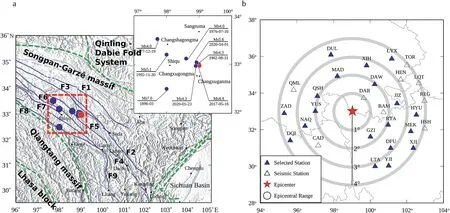
Fig.1.(a) geological structures and located epicenter of earthquakes.(b) seismic epicenter and local stations in Sichuan and surrounding provinces
A large number of studies on the damage produced by the two earthquakes with a magnitude above 5.0 (the 1992 MS5.1 earthquake(Zhang and Wang,1994) and the 2020 MS5.6 earthquake1http://www.scdzj.gov.cn/xwzx/fzjzyw/202004/t20200405_53854.html(last-accessed date 2020-6-16).) have been reported;however,investigations regarding other medium-to-strong earthquakes are limited.According to the earthquake catalogs recorded by the Global Centroid-Moment-Tensor (CMT) and the United States Geological Survey (USGS),no focal mechanism solution and other research information are available for the 2017 MS4.4 Shiqu earthquake.Analyses of the earthquake can complement the data of focal mechanism solutions for medium-to-strong earthquakes in the Qinghai-Tibetan Plateau and supply missing data required for inversion of the crustal stress field in the eastern margin of the plateau.In this study,the focal mechanism and depth of the Shiqu MS4.4 earthquake are obtained using regional digital seismograms collected from immobile broadband seismic station in Sichuan,Qinghai,Tibet,and Gansu provided by Data Backup Center for China Seismograph Network (Zheng et al.,2009) and employing the generalized cut and paste(gCAP)inversion method(Zhao and Helmberger,1994;Zhu and Helmberger,1996;Zhu and Ben-Zion,2013).The effects of crustal velocity structure inaccuracy,location error,data quality,and earthquake parameters on the inversion results are analyzed,and the seismogenic structure of the earthquake is investigated based on the regional geological structure,the spatial distribution features of aftershocks,and the characteristics of regional tectonic stress field.
2.Geological structure background
Since the early Paleozoic Era,Qinghai-Tibetan Plateau has experienced multi-period tectonic activities,forming five roughly eastwest-oriented large suture zones with relatively stable tectonic blocks in between(Zhou,2014).The Shiqu MS4.4 earthquake occurred in the Songpan-Garz^e massif,which is located in the southeastern terminus of the plateau and is confined by the late Paleozoic Amne Machin-Nankunhe suture zone,the early Paleozoic Kulun Mountains suture zone,and the Triassic Hoh Xil-Jinsha River suture zone(Yin and Harrison,2000).The massif has an overall inverted triangle shape and is confined between the Qiangtang terrane,the East Kunlun-West Qinlin Orogen,and the Longmen Mountain thrust nappe (Wang et al.,2016).Additionally,the massif is divided into three parts by two deep faults(Xianshuihe and Garz^e-Litang faults):the Bayan Har geosynclinal fold zone north of the Xianshuihe fault,the Yidun geosynclinal fold zone west of the Garz^e-Litang fault,and the Yajiang River geosynclinal fold zone between two faults(Bureau of Geology and Mineral Resources of Sichuan Province,1987).Under the compression of the Indian Plate in the northeast direction,Qinghai-Tibetan Plateau has experienced shortening in that direction and meanwhile squeezed the interior material outward in the east-southeast direction.Due to this overall compressive tectonic setting and the escape flow of the lithospheric material,a multitude of large strike-slip fault systems (including the Xianshuihe fault) have developed in the plateau(Rowley,1996;Zhang et al.,2004).Inside the Songpan-Garz^e massif,there are a series of sub-parallel,northwest--oriented secondary fault zones,including the Dari,Yuke-Niqu,Bayan Har Mountain,Luhuo-Daowu,Changshagongma,Zarun-Chumar River,Qumalar,and Yushu-Garz^e faults.In general,the Songpan-Garz^e massif is characterized by clockwise rotation and deformation(Zhou,2014).
The Xianshuihe fault zone is a large,deep,northwest-oriented,sinistral,curved strike-slip fault zone spanning across the entire West Sichuan Plateau—starting from Luding,extending northward through Kangding,Luhuo,Garz^e,and Changshagongma,and inserting into Qinhai (Bureau of Geology and Mineral Resources of Sichuan Province,1987).It is a northwest-oriented (with a strike of approximately 310°–330°),northeast-dipping (with a dipping angle of approximately 60°–75°),sinistral strike-slip fault.In a broad sense,the Xianshuihe fault zone includes not only the Xianshuihe fault zone but also the Yushu-Garz^e,Anning-Zemu,and Xiaojiang fault zones (Xu,2009).Accommodating the most intense crustal motion and deformation (Li,1993),the fault zone has been tectonically active for a long periodsince Permian(Bureau of Geology and Mineral Resources of Sichuan Province,1987),and has experienced frequent earthquakes,For example,more than 20 earthquakes with a magnitude above 7.0 have been recorded since the availability of observational data (Zhang and Xie,2001).The Luhuo-Daofu fault is the northwestern section of the Xianshuihe fault zone (Liu et al.,2013).The Changshagongma fault,which joins the Luhuo-Daowu fault and is recognized as a branch of the Luhuo-Daowu fault zone (Huang and Liu,2006),exhibiting intense leftward shear activity.In the Shiqu section of the Changshagongma fault,eight earthquakes with a magnitude above 4.0 have occurred since the availability of seismic record(Fig.1a).
3.Method
Zhu and Helmberger (1996) propose a cut and paste (CAP) method for solving focal mechanism through inversion of regional seismograms.The method fits both body and surface waves rather than using body or surface waves individually.Zhu and Helmberger(1996)modify the CAP method by removing the normalized weighting factor.This modified method is suitable for focal mechanism solution using inaccurate velocity models.The CAP method uses a double-couple source model;however,a large number of earthquakes observed in volcanic and geothermal regions do not have a double-couple source,although the vast majority of tectonic earthquakes are controlled by shear deformation.Moreover,the double-couple source model-based CAP method is not suitable for shock bumps and nuclear explosions either,because a large proportion of the moment tensor of these special earthquakes is isotropic.Zhu and Ben-Zion generalize the CAP method by introducing a non-double-couple source model.The generalized CAP (gCAP) method (Zhao and Helmberger,1994;Zhu and Helmberger,1996;Zhu and Ben-Zion,2013)can obtain the solution of the full tensor by decomposing the focal mechanism in the principal axis coordinate system into isotropic (ISO),double-couple (DC),and compensated linear vector dipole (CLVD)components.The advantages of the gCAP method(Zhao and Helmberger,1994;Zhu and Helmberger,1996;Zhu and Ben-Zion,2013) include increasing the weight of body waves(Pnl)and effectively eliminating the effect of velocity model inaccuracy and earthquake location error.
We set u(t) as the observed displacement;then,for a double-couple source,the theoretical displacement s(t) can be expressed as:

where i=1,2,3 and stand for vertical strike-slip fault,vertical dip-slip fault,and dip-slip fault with a dipping angle of 45°,respectively,M0is the scalar seismic moment,Aiis the radiation coefficient,φ is the azimuth of the seismic station;,Giis the Green function,and θ,δ,and λ are the strike,dip,and dipping angles,respectively.
Set θ,δ,and λ in the range from 0 to 2π,0 to π/2,and 0 to 2π,respectively;then,the actual displacement can be obtained by solving the following nonlinear equation using grid point search method:

The error function is defined as:

where r is the station-epicenter distance,r0is the specified referenced epicentral distance,and p is the scale factor,whose value is determined experientially (Zhu and Helmberger,1996).Generally,surface waves have a larger amplitude than body waves.If the same weight is given to body and surface waves,the goodness of fit for body waves will be limited.Thus,body and surface waves need to be inverted using different scale factors p,which are determined based on the actual circumstances and are commonly set as 1 and 0.5 for body and surface waves,respectively.
Using the above equations,we are able to obtain a series of significant factors,including the error function between the observed and theoretical waveforms,the optimal focal mechanism parameters,and the focal mechanism,depth,and moment magnitude.
4.Data and models
4.1.Distribution of seismograph stations and data sources
Seismograms collected by immobile broadband seismic stations in Sichuan,Qinghai,Tibet,and Gansu are obtained from Data Backup Center for China Seismograph Network (Zheng et al.,2009).The event seismograms from 28 stations with an epicentral distance less than 4°are selected.The data with poor quality or low signal-to-noise ratio have been removed.Finally,the seismograms collected by 18 stations with a good azimuth distribution (Fig.1b) are selected for subsequent focal mechanism inversion.The catalog of earthquake events used in the study is obtained from China Earthquake Networks Center.
4.2.Crustal velocity structure model
The data selected for inversion possess a station-epicenter distance less than 4°.The Crust 2.0 velocity model2https://igppweb.ucsd.edu/~gabi/crust2.html (last-accessed date 2021-11-11)(Bassin et al.,2000)is used,with the S-wave quality factor QSset at 500 and the P-wave quality factor QPset at two times of QS.Thus,an average crustal velocity structure model is obtained for the research area(Table 1).

Table 1 The crustal structure model of studying area.
4.3.Data treatment
The selected regional seismograms are processed through a series of treatments,including format conversion,detrending,demeaning,antitilting,removing the effect of dipping and removing instrument response.The seismic waves are intercepted from 5 s before to 600 s after the theoretical arrival time of P-phase,resampled at a sampling rate of 0.2 s and filtered using a 0.05–2.00 Hz Butterworth bandpass filter to minimize the effect of high-frequency noises.The data of the three components are rotated to the R (radial),T (tangent),and Z (vertical)directions,respectively.The arrival time of P-phase is manually identified.
The theoretical Green functions of the 18 stations at different depths and epicentral distances are obtained using the frequency-wave number(F–K)method(Zhu and Rivera,2002),with the depth set at the range of 0–20 km,spacing at 1 km,and sampling rate at 0.2 s.Integration is performed with respect to the frequency and wave number separately.The entire-wave-field displacement of the earthquake is calculated using a propagator matrix,and we eventually obtain the theoretical seismic waveforms of the body and surface waves at different frequencies.
The time window lengths of body and surface waves for inversion using the gCAP method (Zhao and Helmberger,1994;Zhu and Helmberger,1996;Zhu and Ben-Zion,2013) are set at 30 s and 60 s,respectively.The waveforms of events are cut into two parts:body waves(Pnl)and surface waves(S).Due to the relatively small earthquake magnitude,the waveforms are filtered using a fourth-order Butterworth bandpass filter at 0.05–0.1 Hz to improve the signal-to-noise ratio and thus ensure the reliability of the results.The scale factors p for body and surface waves are set at 1 and 0.5,respectively.The step lengths for searching focal mechanism and seismic magnitude are set at 5°and 0.1,respectively.
The theoretical seismograms are filtered in the same frequency band used for filtering the observed seismograms.Waveform fitting is performed to the observed and theoretical seismograms using grid searchand cross correlation methods,for searching the optimal focal mechanism solution with minimizing error as the objective function by global search(Zhao and Helmberger,1994;Zhu and Helmberger,1996).
5.Results
5.1.Focal mechanism solution
The focal mechanism solution of the Shiqu MS4.4 earthquake is obtained using the gCAP method (Zhao and Helmberger,1994;Zhu and Helmberger,1996;Zhu and Ben-Zion,2013) based on the seismograms collected from the 18 seismic stations(Fig.1a),and the crustal structure model is presented in Table 1.The results(Fig.2a)show that nodal plane I has a strike of 214°,a dip of 80°,and a dipping angle of 167°and nodal plane II has a strike of 306°,a dip of 77°,and a dipping angle of 10°.Pand T-axes have azimuths of -99.6°and 169.9°and dips of 1.9°and 16.2°,respectively.A comparison of the theoretical and observed seismograms (Fig.2a) show that among the 90 seismic phases from the 18 digital waveform records,65 accounting for 72% of all phases have a correlation coefficient greater than 0.8,and 46 accounting for 51%of all phases have a correlation coefficient greater than 0.9,indicating a strong correlation.Besides,the root mean square(RMS)error is 4.076×10-4,which belongs to good fitting of the waveforms indicative of high reliability of the obtained focal mechanism solution parameters.
5.2.Focal depth and moment magnitude
The focal mechanism solution error is defined as a function of the focal depth(Xu et al.,2019).Focal mechanisms at depths of 1–20 km are calculated according to the trends of which error varies with the focal depth.In addition,the depth corresponding to the focal mechanism solution with the smallest RMS error is considered as the optimal centroid depth.By performing inversions at different depths,the Shiqu MS4.4 earthquake is estimated to be a shallow-focus earthquake with an optimal mass center depth of 7.3 ± 0.6 km and an magnitude of MW4.52.As shown in Fig.2b,the results of inversions at different depths varied slightly except for those at near-surface depths,and all solutions show that the earthquake is dominated by strike-slip mechanism,indicating that the focal mechanism solutions are highly stable and reliable.
6.Analysis and discussion
The reliability of focal mechanism inversion is mainly affected by the following factors:1) crustal velocity structure inaccuracy,including the velocities and quality factors of S and P waves;2) epicenter location accuracy;3) data quality;and 4) source parameter which are set with different values by different research institutes.To test the stability and reliability of the focal mechanism solutions,the effects of the above four factors are investigated separately as follows:
6.1.Effect of velocity structure model
Inversions are performed to the same data using the gCAP method(Zhao and Helmberger,1994;Zhu and Helmberger,1996;Zhu and Ben-Zion,2013) but meanwhile varying the QSand QPsettings for the velocity structure model (Table 2) according to the values of quality factor of the continental crust in China(Wang et al.,2008)and updating the Green function accordingly.The results(Table 5)show that the focal mechanism solutions and depths obtained using the new settings differed slightly as compared with that obtained using the original setting.The optimal depth of the mass center increases by 0.2 km.The RMS error is 4.022×10-4,decreasing by 0.054×10-4.The seismic magnitude is MW4.63,varying by 0.01.These results indicate that varying the quality factor Q does not affect the focal mechanism solution and depth,thereby playing an insignificant role in the depth of the mass center and seismic magnitude.
To test the effects of the velocities of S and P waves,the same data are inverted using the gCAP method(Zhao and Helmberger,1994;Zhu and Helmberger,1996;Zhu and Ben-Zion,2013) but separately increasing and decreasing the velocities of the shear and compress waves by 5%and updating the velocity structure model and Green function accordingly.The results (Table 5) show that the focal mechanism solution obtained using the high-velocity anomaly model does not differ from that obtained using the original settings and the seismic magnitude and focal depth varied to MW4.56 and 7 km,respectively.The focal mechanism solution and focal depth obtained using the low-velocity anomaly model is in accord with those obtained using the original wave velocity settings,and the magnitude decreases to MW4.47.Compared with the results obtained using the Crust 2.0 velocity model,the magnitude,optimal depth of the mass center,and RMS error obtained using the new velocity models differ slightly (slight increase or decrease),and the focal mechanism solution remains unchanged.In summary,increasing the perturbance by the velocity of S and P waves does not affect the focal mechanism solution and exerts a certain effect on the solution of the magnitude and optimal depth of the mass center.
The middle crust of Qinghai-Tibetan Plateau is widely distributed with partially melted or hydrous viscous fluids,which are characterized by low velocity,high conductivity,and a different structure as compared with the upper crust consisting of brittle layers (Brown et al.,1996;Nelson,1996;Li et al.,2017).The data are inverted using the gCAP method (Zhao and Helmberger,1994;Zhu and Helmberger,1996;Zhu and Ben-Zion,2013)but adding a low-velocity layer in the middle crust base on the receiver function results for the eastern margin of the Qinghai-Tibetan Plateau (Zhu et al.,2017) and updating the velocity structure model accordingly (Table 3).The results (Table 5) show that the strike,dip,and dipping angle obtained by adding a low-velocity layer in the middle crust have varied by 2°,4°,and 1°,respectively;the moment magnitude has varied by 0.04;the focal depth remains unchanged.The results show that the focal mechanism solution has varied by less than 5°,indicating that adding a low-velocity layer in the middle crust has exerted only little effect on the results of inversion.

Table 2 The crustal structure model of studying area after adjusting Q value.

Table 3 The crustal structure model of adding low-velocity layer in the middle crust.
In summary,velocity structure model inaccuracies have an insignificant effect on the solution of focal mechanism,optimal depth of center of mass,and earthquake magnitude,indicating that the gCAP method(Zhao and Helmberger,1994;Zhu and Helmberger,1996;Zhu and Ben-Zion,2013)is robust for velocity structure model inaccuracies.
6.2.Effect of location error
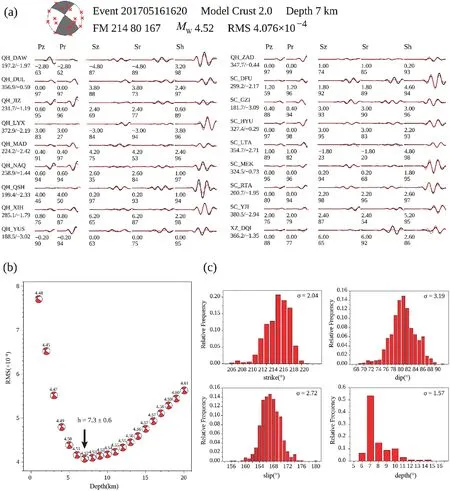
Fig.2.(a) The result of focal mechanism and comparison between synthetic (red) and observed (black) waveforms.(b) RMS of focal mechanism as a function of source depth.(c) Bootstrapping of focal mechanism inversions.
In general,earthquake location error is not greater than 3 km (Xie et al.,2012).To test the effect of location error on the results of inversion,we change the location by moving the epicenter to east,west,south,and north by 5 km separately,then the inversions are carried out.The results(Table 5) show that the inversion results are barely affected by the variation of the coordinate position of the epicenter:the strike,dip,and dipping angles of the focal mechanism solution have varied by less than±1°.All solutions show that the earthquake is dominated by strike-slip mechanism,the moment magnitude has varied by approximately±0.01,and the focal depth has varied by less than 1 km,the effect of location error on the focal mechanism solution is extremely weak.
6.3.Effect of data quality
For the initial inversion,stations with poor quality data are removed from the original dataset of seismograms collected from 28 seismograph stations,and only seismograms collected from 18 stations with high data quality and even azimuth distribution are selected for focal mechanism inversion.To test the effect of data quality,an inversion step is performed by adding seismograms of four stations with relatively good data quality back to the dataset for focal mechanism inversion.The results(Table 5)show that decreasing the data quality has only an insignificant effect on the results of inversion:only the strike of the focal mechanism solution has varied by 1°,the moment magnitude has varied by only 0.02,and the focal depth remain unchanged.Finally,an inversion is performed using the full original dataset of seismograms collected from 28 stations.The results show that further decreasing the data quality has an insignificant effect on the inversion:the strike,dip,and dipping angle of the focal mechanism solution have all varied but by less than 1°;the moment magnitude has varied by a small value of 0.01;and the focal depth stays unchanged.Therefore,we suggest that data quality has an insignificant effect on the focal mechanism solution and the data inversion method is robust with respect to data quality.
6.4.Analysis of uncertainty
The uncertainty of focal mechanism solutions is analyzed using the bootstrap method (Efron and Tibshirani,1986) according to the error estimation approach proposed by Sheng et al.(2020).The dataset of the seismograms collected from the selected 18 stations (Fig.1b) is resampled using the bootstrap method as follows:each data sample is drawn from the dataset randomly and returned to the dataset after it is selected,that is,seismograms collected from the same station are possibly selected two or more times,while those collected from other stations may never be selected.A sample of seismograms collected from one station is drawn from the dataset of 18 stations,and a total of 18 such samples are drawn for inversion.An inversion step is performed using the same gCAP method and the dataset consisting of the 18 resampling samples.The resampling stepis repeated 1 000 times,thereby obtaining 1000 focal mechanism solutions.The standard deviations of the strike,dip,dipping angle,and focal depths obtained using the bootstrap samples are 2.04°,3.19°,2.72°,and 1.57 km,respectively.Fig.2c shows the frequency distribution of 1000 focal mechanism solutions,of which the strike,dip,dipping angle,and focal depth exhibit highly concentrated distributions,indicating that the focal mechanism solutions are reliable.
6.5.Effect of source parameters
The result of epicentral location varies as the station distribution,data selection,and location method vary.Different research institutes have provided different earthqurake parameters for the MS4.4 earthquake occurred in Shiqu,Sichuan on May 16th,2017 (Table 4).Three organizations such as the USGS,Sichuan Earthquake Networks Center(SENC),and China Earthquake Networks Center(CENC)have recorded different origin times,epicenters,magnitudes,and focal depths for the earthquake.Focal mechanism inversions are performed using the three different versions of the earthquake parameters.The results (Table 5)show that the earthquake parameters barely affect the focal mechanism solution except for slight variations in the depth of mass center.The solutions obtained using the three different versions of earthquake parameters are highly consistent,indicating that the solutions are reliable.
6.6.Center of focal mechanism solution and stability
The focal mechanism solutions obtained using different values of the influencing factors are inconsistent to a certain extent.To test the stability of the results,centers of the focal mechanism solutions and standard deviations which are obtained using the individual focal mechanism solutions as the initial value separately are obtained (Wan,2019).The results (Table 6) show that the standard deviations differ in the one thousandths place,indicating that the focal mechanism solutions are stable.The minimum of the standard deviations of the focal mechanism solution centers which are obtained using the individual focal mechanism solutions as the initial value separately is 1.812914.The sequence number of the optimal center of solution is 1.The final center of focalmechanism solution is as follows:nodal plane I:214.43°/80.85°/167.27°;nodal plane II:306.49°/77.44°/9.38°;P-axis has strike and dips of 260.78°and 2.37°,with the uncertainty ranging from 259.15°to 262.15°and from 1.27°to 3.55°,respectively;T-axis has strike and dips of 170.12°and 15.44°,with the uncertainty ranging from 168.49°to 171.49°and from 14.29°to 16.41°,respectively.The standard deviation of the minimum three-dimensional space rotation angles obtained using the focal mechanism solution in the first row as the initial value is the smallest,the value is 1.8129.The initial and central focal mechanism solutions are plotted on the same focal sphere (Fig.3).The solutions exhibit a highly concentrated distribution and are basically consistent,indicating that the solutions are stable and reliable.

Table 4 earthquake parameters from different institutes.

Table 5 Focal mechanism solution under various conditions.
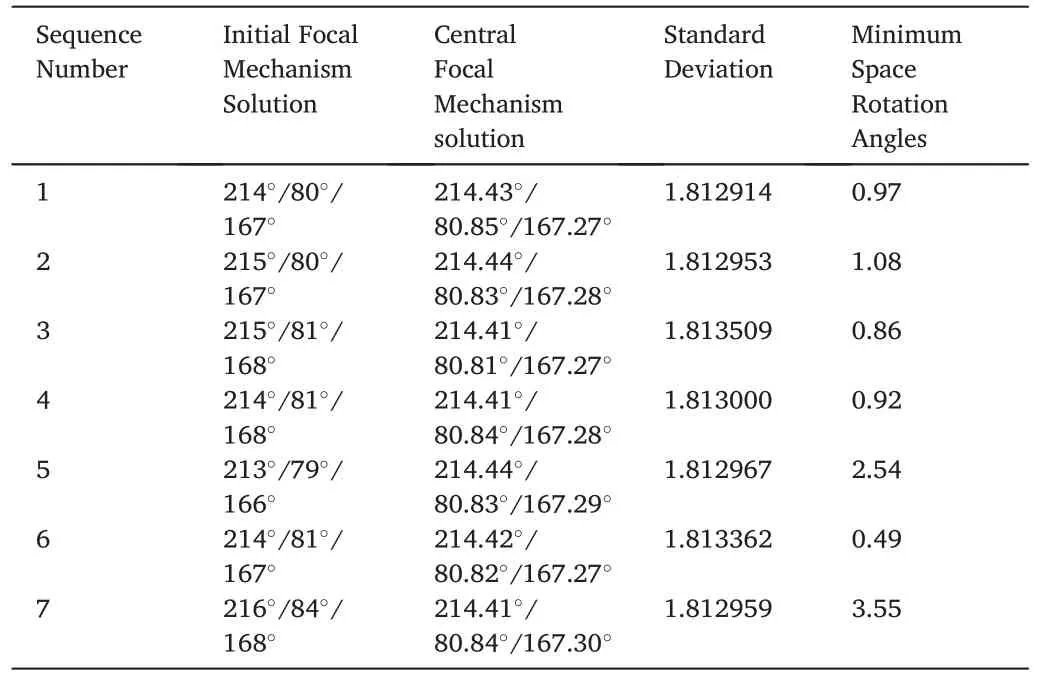
Table 6 Central focal mechanism given by different focal mechanism solutions and residuals.
6.7.Seismogenic structure
The focal mechanism solution obtained for the earthquake is as follows:nodal plane I:214°/80°/167°;nodal plane II:306°/77°/10°.Either of the two nodal planes may be the actual seismogenic fault,which needs to be determined based on the geological structures of the source region,the epicenter distribution of the aftershocks,and the direction of the major axis of isoseismal lines.However,no geological field survey of the earthquake has been reported;thus,no information about the seismic intensity distribution is available.Since the distribution characteristics of aftershocks can basically reveal the extension direction of the rupture in the seismogenic fault(Xu et al.,2019),the seismogenic structure is first estimated based on the distribution characteristics of aftershock epicenters.
The Shiqu MS4.4 earthquake is followed by only three aftershocks as of May 25th,2017,a 61-day period of calmness (no occurrence of even small shocks) and an ML2.4 earthquake on July 25th,2017.In terms of the distribution characteristics of the Shiqu MS4.4 earthquake and the three aftershocks,the aftershocks have propagated on one side of the main shock in the northwest direction,exhibiting a prominent northwest-oriented linear distribution.As shown in Fig.4,the aftershocks are mainly distributed on the northwestern side of the main shock(the rupture of which mainly propagated in the northwest direction)and rupture on one side of the main shock in the northwest direction.
Due to a small number of aftershocks following the Shiqu MS4.4 earthquake,to ensure the reliability of the seismogenic fault estimation,an earthquake of the same magnitude level occurred in the region is selected for comparative analysis.An MS4.3 earthquake with a focal depth of 13 km occurred in Shiqu (32.97°N,98.87°E) at 22:26 on January 23rd,2020.This earthquake is another intermediate-magnitude strike-slip earthquake (Fig.4) occurred in the same region,and the distance between the two earthquakes is only 13.4 km (Fig.1a).The focal mechanism solution obtained for the 2020 MS4.3 earthquake is as follows:nodal plane I:134°/82°/11°;nodal plane II:42°/79°/171°;azimuths of P-and T-axes are-92°and-1.5°,respectively;the dips are 2.0°and 13.4°,respectively;the optimal depth of centroid is 9 km(Yang et al.,2021).The 2020 MS4.3 earthquake is followed by 36 aftershocks as of March 25th,2020,all of which have been located.The main shock and aftershocks are relocated using the HypoDD relative location method(Waldhauser and Ellsworth,2000).The relocated aftershocks display a concentrated distribution.As shown in the upper right inset of Fig.4,the aftershocks propagate in the northwest direction,and mainly occur in the vicinity of the main shock on the northeastern side,exhibiting a trend of dipping in the northeast direction.The earthquake occurred near the Changshagongma fault,which is a sinistral strike-slip fault with a strike of approximately 310°–330°and a dip of approximately 60°–75°.Based on the geological structures of the source region,the distribution of the aftershocks,and the obtained focal mechanism solution,nodal plane 1(strike:134°;dip:82°;dipping angle:11°) of the focal mechanism solution is consistent with the attributes of the Changshagongma fault,and the major distribution direction of the aftershocks is basically consistent with the attributes of nodal plane I.Therefore,it is more reasonable to deduct that nodal plane I of the focal mechanism solution is the seismogenic structure of the Shiqu MS4.3 earthquake (Yang et al.,2021).The focal mechanism solution of the 2017 Shiqu MS4.4 earthquake is basically consistent with that of the 2020 Shiqu MS4.3 earthquake.The two earthquakes have equivalent azimuths and dips of P-and T-axes,basically consistent depths of the mass center,similar aftershock distributions,epicenters with a close distance in between,and consistent geological structures.Thus,it is speculated that the two earthquakes are induced by similar seismogenic faults.
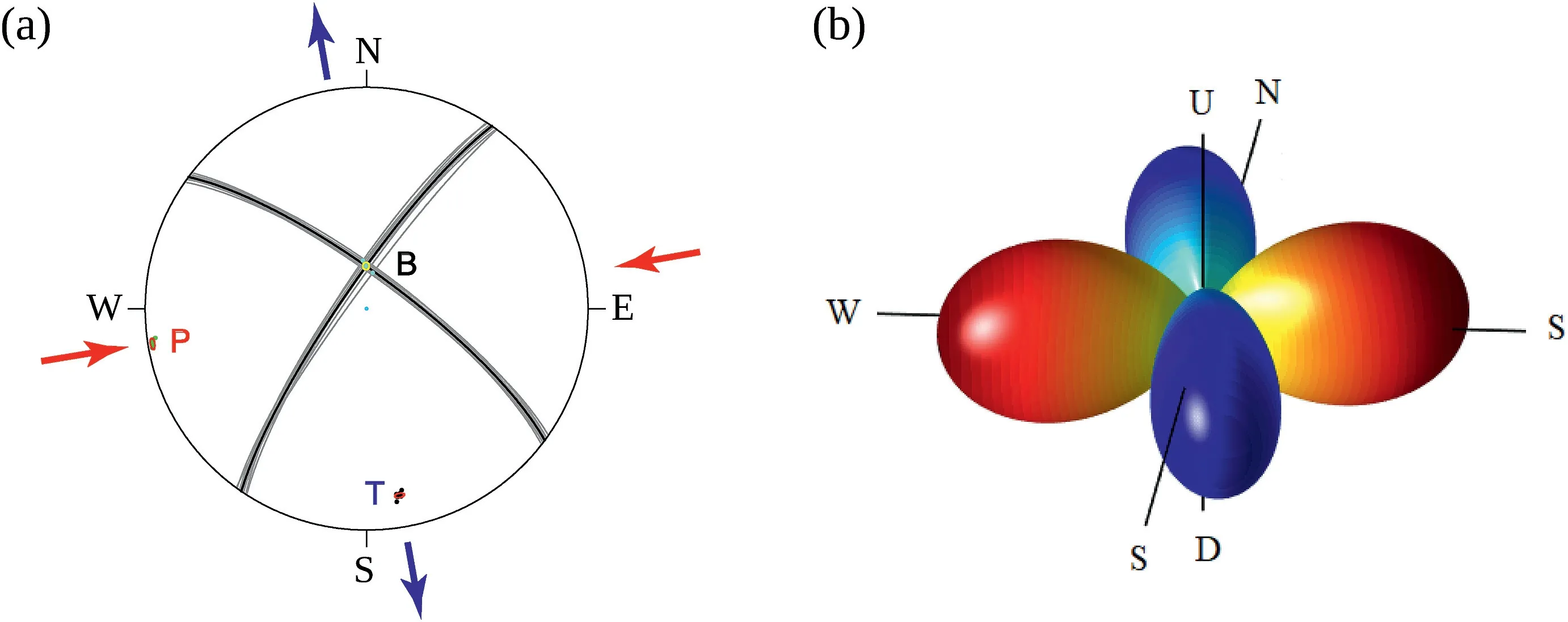
Fig.3.Central focal mechanism (a)and its 3-D radiation pattern (b).In (a),black curves indicate nodal planes of central focal mechanism,gray curves denote focal mechanisms derived by different research institutes.In(b),the red and blue color indicate extensive and compressive areas,respectively.W:West;E:East;N:North;S:South;U:Up;D:Down.
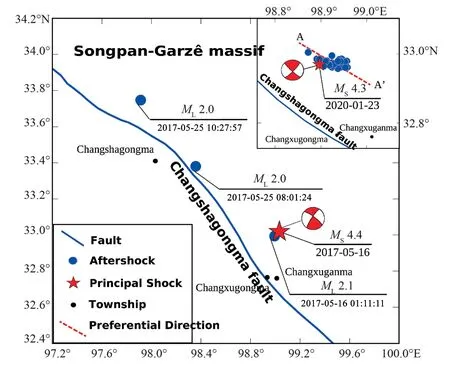
Fig.4.Aftershock sequences and focal mechanisms.
Qinghai-Tibetan Plateau is compressed by the Indian Plate in the northeast direction and experiences the eastern escape flow of the interior material(Xu,2017).Due to the rigid blocking by the Sichuan Basin,the escape flow splits into two branches:one part escaping in the southeast and northeast directions and the other part descending into the mantle (Zhang et al.,2010).According to global positioning system velocity observations,the eastern margin of Qinghai-Tibet Plateau is characterized by overall clockwise rotation and deformation (Zhou,2014).The tectonic stress field of the eastern margin of the Qinghai-Tibetan Plateau shows that the directions of the maximum and minimum principal stresses have markedly different distributions in various places.The direction of the maximum principal stress varies from NNE to NE,EW,and NW as the location varies from north to south.The direction of the minimum principal stress also exhibits a prominent characteristic of clockwise rotation on spatial distribution (Cui,2018).The azimuths of P-and T-axes of the focal mechanism solution for the 2017 Shiqu MS4.4 earthquake are-99.6°and 169.9°,respectively,and are consistent with the direction of maximum principal stress in the Shiqu region,which is approximately EW(Cui,2018).
The Xianshuihe fault zone,which consists of large,deep faults,is one of the major earthquake zones in China,with a sinistral rotation,horizontal slip rate above 10 mm/a(Li et al.,1994).The earthquake occurred in the northwestern-extension section of the Xianshuihe fault zone.The Changshagongma fault,which is located near the epicenter,is a NW-trending and left-lateral strike-slip reverse fault,and dips towards northeast.The shear action in the source region is the principal seismogenic mechanical factor.The NW-trending faults have experienced larger tectonic shear stress and smaller normal stress than the NE-trending ones(Bureau of Geology and Mineral Resources of Sichuan Province,1987);therefore,they are prone to slip in a shear stress field.This is confirmed by the intensive left-lateral shear activity of the Changshagongma fault(Huang and Liu,2006).
In summary,based on the geological structures of the source region,the distribution of the aftershocks,the characteristics of the regional tectonic stress field,and a comparative analysis of the focal mechanism solution obtained for a same-type earthquake occurred in the same region,the following conclusions can be drawn:nodal plane II of the focal mechanism solution (306°/77°/10°) is consistent with the attributes of the Changshagongma fault;the predominant direction of aftershock distribution matches the strike of the nodal plane II;the direction of the maximum and minimum principal stresses of the regional tectonic stress field are consistent with the azimuths of the P-and T-axes of the obtained focal mechanism solution,respectively.Thus,it is speculated that the Changshagongma fault is the seismogenic fault of the 2017 Shiqu MS4.4 earthquake,which is induced by left-lateral strike-slip mechanism and has strike,dip,and dipping angles of 306°,77°,and 10°,respectively.
7.Conclusion
An MS4.4 earthquake occurred in Shiqu County(33.05°N,99.00°E),Sichuan Province at 00:20 Beijing time on May 16th,2017.The earthquake has a focal depth of 10 km and the epicenter is located in the Songpan-Garz^e massif.In this study,the focal mechanism solution is obtained using the gCAP method.The strike/dip/dipping angle of the first nodal plane of optimal double couple solution is 214°/80°/167°and those of the second nodal plane are 306°/77°/10°.The optimal centroid depth is 7.3 ± 0.6 km and the moment magnitude is MW4.5.The azimuths and dips of P and T are -99.6°,1.9°and 169.9°,16.2°,respectively.We then examine the result robustness with regard to some main influencing factors including the crustal velocity structure,location error,data quality and difference of seismic parameters.Furthermore,the center of focal mechanism solution is obtained using the focal mechanism solutions under different influencing factors.As a result,all solutions exhibit a highly concentrated distribution and are basically consistent,indicating that the results are stable and reliable.According to the characteristic of geological structure in the seismogenic area,space distribution of aftershock sequence and characteristics of regional tectonic stress field,together with the comparative analysis of a same-magnitude earthquake occurred in this region,we preliminarily suggest that the Shiqu earthquake is associated with a left-lateral strike-slip mechanism and the second nodal plane is inferred to be the seismogenic fault.Such mechanism agrees well with the geometry of Changshagongma fault which is the secondary fault of the northwest part of the Xianshuihe fault zone.
Acknowledgments
We thank China Earthquake Networks Center for providing the catalog of earthquake events,Sichuan Earthquake Networks Center for providing the catalog of aftershocks,Sichuan Earthquake Agency for providing the seismic phase observations used for earthquake relocation,and National Seismograph Network Data Backup Center for China Seismograph Network (https://doi.org/10.11998/SeisDmc/SN) of the Institute of Geophysics,China Earthquake Administration for providing the seismograms used in this study.We appreciate Professor Lupei Zhu for providing the gCAP program package,Professor Yongge Wan at the Institute of Disaster Prevention for providing the program to search the center of focal mechanism,some of the figures were created by Generic Mapping Tools(www.soest.hawaii.edu/gmt,last-accessed date 2021-11-11;Wessel et al.,2013),Additionally,we express special thanks to senior engineer Li Dahu at Sichuan Earthquake Agency for providing useful discussion of this analysis,and the anonymous reviewers for their valuable suggestions which had greatly improved the quality of this manuscript.This Project is sponsored by The Key Project of Director Fund of Earthquake Agency of Inner Mongolia Autonomous Region,China(2020TM04),the Key Youth Task of Earthquake Emergency of China Earthquake Administration,China (CEA_EDEM-202103) and Project of Director Fund of Earthquake Agency of Inner Mongolia Autonomous Region,China(2019JC27).
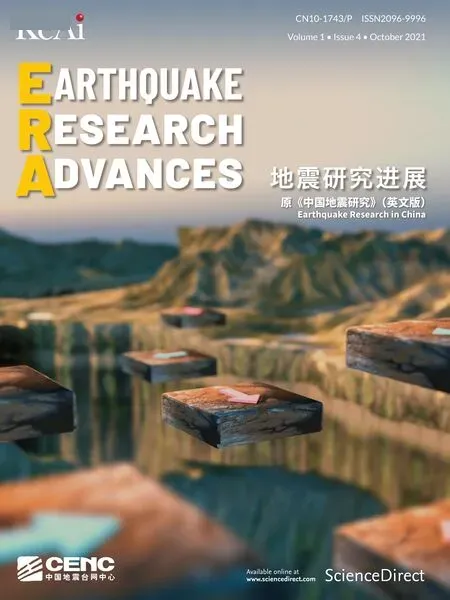 Earthquake Research Advances2021年4期
Earthquake Research Advances2021年4期
- Earthquake Research Advances的其它文章
- Experimental study on the influence of seismic subsidence of loess under bidirectional loading modes
- A classification method of building structures based on multi-feature fusion of UAV remote sensing images
- Fault detection by reflected surface waves based on ambient noise interferometry
- The advance in obtaining fault slip rate of strike slip fault-A review
- GUIDE FOR AUTHORS
- Aims &Scope:
